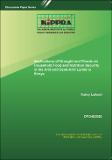| dc.description.abstract | The cycles of drought and floods in Kenya have become shorter and are now
2- 3 years, which has resulted in unprecedented challenges regarding household
food and nutrition security, especially in the arid and semi-arid areas. Data for
this study were collected from both secondary (national statistics) and primary
sources, where interviews were carried out with 1,370 randomly selected
households based on NASSEP V (KNBS) using a structured questionnaire. The
survey covered 27 counties, specifically 23 arid and semi-arid counties plus 4
counties that were prone to floods, and was conducted between February and
March 2018. The analytical techniques used included descriptive statistics of
respondents’ characteristics and linear regression analysis to identify factors
influencing their household food security. The results show that the arid and
semi-arid lands of Kenya are vulnerable to food insecurity especially during
incidence of drought and floods. The situation in the country is not getting
better, which is evident by the increasing number of undernourished citizens.
There is need to diversify the food groups that Kenyans consume. Three food
groups constitute half of the household food basket: milk, maize, wheat, and
their respective products. Households in the sampled counties are net food
buyers due to their reliance on rainfed agriculture - mainly livestock production
systems. Regarding factors influencing household food and nutrition security,
the household head’s age, gender, and education level contributed positively to
the status of the household. While the presence of assets, access to credit and
remittance also contribute positively to household food and nutrition security.
The study recommends that production systems need to be transformed by
introducing technology such as irrigation to reduce dependence on rainfall, and
at the same time introduce insurance mechanisms against the impact of weatherrelated
shocks. Finally, there is need to strengthen markets to minimize supply
failures, thus reducing chronic poverty, by introducing a range of pre-emptive
measures, including building transport infrastructure to integrate markets and
build asset buffers at the household level to reduce their vulnerability. | en |

